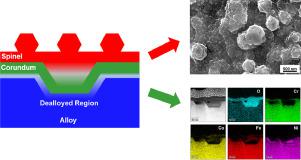当前位置:
X-MOL 学术
›
Acta Mater.
›
论文详情
Our official English website, www.x-mol.net, welcomes your feedback! (Note: you will need to create a separate account there.)
Competition between Thermodynamics, Kinetics and Growth Mode in the Early-stage Oxidation of an Equimolar CoCrFeNi Alloy
Acta Materialia ( IF 9.4 ) Pub Date : 2020-09-01 , DOI: 10.1016/j.actamat.2020.06.056 Xiao-Xiang Yu , Matthew A. Taylor , John H. Perepezko , Laurence D. Marks
Acta Materialia ( IF 9.4 ) Pub Date : 2020-09-01 , DOI: 10.1016/j.actamat.2020.06.056 Xiao-Xiang Yu , Matthew A. Taylor , John H. Perepezko , Laurence D. Marks

|
Abstract We demonstrate that the early-stage oxidation of a CoCrFeNi multi-principal element alloy depends upon competition between kinetic and thermodynamic factors involving the relative diffusion rate of cations and oxygen, and how this couples to inward or outward oxide growth. The microstructures of oxide layers formed at temperatures from 500 to 800°C for 0.5 h, as well as their chemical compositions, were investigated by transmission electron microscopy. A triple layer microstructure with an outer Fe-rich spinel oxide, an intermediate Cr-rich corundum structure, and a Ni-rich (Fe, Co, and Cr depleted) dealloyed region at the metal/oxide interface was observed. The dominant oxygen transport in corundum at 800°C and below led to an inward growth of the corundum phase; the spinel oxide growth was dominated by cation diffusion, so it grew outward. The chromium was sequestered in the corundum layer, thereby favoring the formation of the chromium-free, Fe-rich spinel oxides with Co and Ni dopants. Since nickel cannot readily diffuse through corundum, it tends to remain in the alloy phase leading to the Ni-rich dealloyed region at the metal/oxide interface. Beyond the microstructure results, we exploit secondary electron image contrast to show the doping nature of the oxides, a p-type spinel and a n-type corundum growing on the metal surface.
中文翻译:

等摩尔 CoCrFeNi 合金早期氧化过程中热力学、动力学和生长模式之间的竞争
摘要 我们证明了 CoCrFeNi 多主元素合金的早期氧化取决于动力学和热力学因素之间的竞争,包括阳离子和氧的相对扩散速率,以及这如何与向内或向外的氧化物生长耦合。通过透射电子显微镜研究了在 500 到 800°C 的温度下 0.5 小时形成的氧化物层的微观结构及其化学成分。在金属/氧化物界面处观察到具有外部富铁尖晶石氧化物、中间富铬刚玉结构和富镍(Fe、Co 和 Cr 耗尽)脱合金区域的三层微观结构。800°C 及以下的刚玉中主要的氧传输导致刚玉相向内生长;尖晶石氧化物的生长以阳离子扩散为主,所以它向外生长。铬被隔离在刚玉层中,从而有利于形成含有 Co 和 Ni 掺杂剂的无铬、富含 Fe 的尖晶石氧化物。由于镍不容易通过刚玉扩散,它倾向于保留在合金相中,导致金属/氧化物界面处的富镍脱合金区域。除了微观结构结果之外,我们利用二次电子图像对比度来显示在金属表面生长的氧化物、p 型尖晶石和 n 型刚玉的掺杂性质。
更新日期:2020-09-01
中文翻译:

等摩尔 CoCrFeNi 合金早期氧化过程中热力学、动力学和生长模式之间的竞争
摘要 我们证明了 CoCrFeNi 多主元素合金的早期氧化取决于动力学和热力学因素之间的竞争,包括阳离子和氧的相对扩散速率,以及这如何与向内或向外的氧化物生长耦合。通过透射电子显微镜研究了在 500 到 800°C 的温度下 0.5 小时形成的氧化物层的微观结构及其化学成分。在金属/氧化物界面处观察到具有外部富铁尖晶石氧化物、中间富铬刚玉结构和富镍(Fe、Co 和 Cr 耗尽)脱合金区域的三层微观结构。800°C 及以下的刚玉中主要的氧传输导致刚玉相向内生长;尖晶石氧化物的生长以阳离子扩散为主,所以它向外生长。铬被隔离在刚玉层中,从而有利于形成含有 Co 和 Ni 掺杂剂的无铬、富含 Fe 的尖晶石氧化物。由于镍不容易通过刚玉扩散,它倾向于保留在合金相中,导致金属/氧化物界面处的富镍脱合金区域。除了微观结构结果之外,我们利用二次电子图像对比度来显示在金属表面生长的氧化物、p 型尖晶石和 n 型刚玉的掺杂性质。



























 京公网安备 11010802027423号
京公网安备 11010802027423号